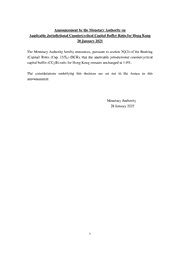
ccyb announcement 210128 PDF
Preview ccyb announcement 210128
Announcement by the Monetary Authority on Applicable Jurisdictional Countercyclical Capital Buffer Ratio for Hong Kong 28 January 2021 The Monetary Authority hereby announces, pursuant to section 3Q(3) of the Banking (Capital) Rules (Cap. 155L) (BCR), that the applicable jurisdictional countercyclical capital buffer (CCyB) ratio for Hong Kong remains unchanged at 1.0%. The considerations underlying this decision are set out in the Annex to this announcement. Monetary Authority 28 January 2021 1 Annex Decision In reaching his decision to keep the Hong Kong jurisdictional CCyB ratio unchanged at 1.0%, the Monetary Authority reviewed a range of quantitative indicators and qualitative information. This included the “indicative buffer guide” produced by the Monetary Authority’s Initial Reference Calculator (IRC) which is a metric that takes into account conditions in local credit and property markets. By mapping deviations (“gaps”) of the ratios of (i) credit to GDP; and (ii) residential property prices to rentals; from their respective long term trends to the Basel III CCyB range of 0% to 2.5%, the IRC produces a consistent starting point for further analysis. A gap has to be greater than 2% to be regarded as significant for the purposes of the IRC, and has to reach 10% to signal a 2.5% CCyB. The latest IRC, calculated based on 2020Q3 data, signals a CCyB of 2.5%. The projection based on all available data suggests that the IRC would very likely signal a lower CCyB than this when all relevant 2020Q4 data become available, and the IRC is expected to be volatile in the current circumstances. The setting of the CCyB for Hong Kong is however not a mechanical exercise and the Monetary Authority always considers a broad range of information in addition to the indicative buffer guide produced by the IRC. In particular, the Monetary Authority also reviewed a series of “Comprehensive Reference Indicators” and all relevant information available at the time of decision. The information drawn from all these sources suggests that the economic environment in Hong Kong is still subject to a high level of uncertainty at the moment. The Monetary Authority considered that it is more appropriate to keep the CCyB unchanged at 1.0% and continue to monitor the situation for a few more quarters. The Monetary Authority will continue to monitor credit and economic conditions in Hong Kong closely and the CCyB ratio will be reviewed on a quarterly basis or more frequently. Background The CCyB is part of the Basel III regulatory capital framework and is being 2 implemented in parallel by Basel Committee member jurisdictions worldwide. The CCyB has been designed by the Basel Committee to increase the resilience of the banking sector in periods of excess credit growth. The banking sector can then act as a “shock absorber” in times of stress, rather than as an amplifier of risk to the broader economy. The power to implement the CCyB in Hong Kong is provided by the Banking (Capital) Rules, which give the Monetary Authority the power to announce the CCyB ratio applicable to Hong Kong. The specific CCyB requirement applicable to a given Authorized Institution (AI) is expressed as a percentage of its CET1 capital to its total risk-weighted assets (RWA). Each AI’s CCyB requirement may vary depending on the geographic mix of its private sector credit exposures and the CCyB applicable in each jurisdiction where it has such exposures. As an initial reference for the Monetary Authority to assess the extent of system-wide risks resulting from excessive credit growth and determine the corresponding level of the CCyB requirement, the Monetary Authority uses a methodology that synthesises information from two main indicators, namely the size of the deviation of the credit/GDP ratio and the residential property price/rent ratio from their respective long-term trends, where the trends are estimated using historical data with a method (recommended by the Basel Committee and commonly used in macroeconomics to detect cyclical fluctuations) that gives a higher weight to more recent observations. A high credit/GDP gap signals significant leverage in the non-bank private sector (as the accumulated effect of above-trend credit growth over a period of time) and therefore vulnerability to negative shocks such as an increase in interest rates or a fall in income. A high residential property price/rent gap signals potentially unsustainably high property valuations (as a result of above-trend price increases over a period of time) and therefore vulnerability to a major market correction. However, the Monetary Authority also assesses a broader set of indicators and other relevant information before reaching a decision on the appropriate level of the CCyB. 3
